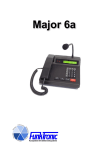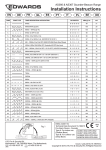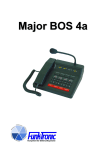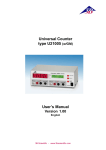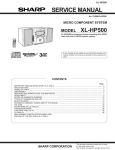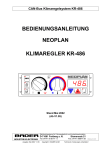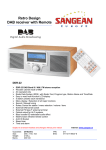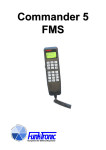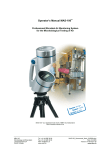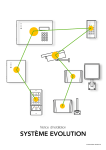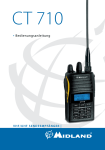Download Line Interface
Transcript
Line Interface FT 634a, FT 634aC, FT 634aCL Contents page Technical Data General Features Channel switching Option line monitoring Transmitter control Functions of the LEDs Examples Jumper Block diagram FT634a (C, CL, TRC) Block diagram DSP Pinout RS232-connecting cable Service program/Adjustment Programming Decoder functions FT634aC Alarm transmission from FT634aC to Major 4a/5a Inputs initiating tone sequences Option: Line monitoring (FT 634a CL) Tontabelle General Safety Instructions Terms and abbreviations -2Kompetent für Elektroniksysteme 3 4 5 5 5 5 6 8 9 10 11 13 13 15 18 20 21 22 23 24 25 ft634a (06.02.2014) Technical Data Voltage of operation +12V DC +/-30% Current demand ca. 100 mA Fuse 1 A, self-resetting Weight ca. 525 g Dimensions W x H x D 104 x 44 x 175 mm Frequency of pilot tone ex factory setting: 3300 Hz Pilot tone decoder +/- 0,8 % (+/- 26 Hz) Response time < 20 ms Release time < 40 ms min. pilot tone level at measuring (monitor.)point 75 mV Notchfilter pilot tone suppression > 50 dB 2- resp. 4-wire Input level 2-wire Adjustment range 2-wire Input level 4-wire Adjustment range 4-wire Input impedance Output level 2-wire Pilot tone 2-wire Output level 4-wire Pilot tone 4-wire Output impedance 2-wire Output impedance 4-wire -10 dBm nominally, 250 mV -41 dBm to -1 dBm, 7 mV to 700 mV -9 dBm nominally, 275 mV -40 dBm to +1 dBm, 8 mV to 850 mV 2-wire Zr or 600 Ohm, 4-wire 600 Ohm -10 dBm, 250 mV (or: -19 dBm, 190 mV) -12 dBm, 200 mV -14 dBm, 150 mV (or: -5 dBm, 450 mV) -16 dBm, 125 mV Zr or 600 Ohm 600 Ohm Interface radio device resp. desk top control Input level + 3 dBm nominally, 1100 mV Adjustment range - 24 to + 6 dBm, 50 mV to 1550 mV Input impedance 600 Ohm Output level - 17 dBm ex factory setting, 100 mV Adjustment range - 30 to + 8 dBm, 25 mV to 2000 mV Output impedance 600 Ohm -3Kompetent für Elektroniksysteme ft634a (06.02.2014) General Features The new line interface FT634a is completely constructed in SMD-technology. The connections are pin-compatible with the former version, but instead of male connectors there are female connectors. The line interface is used to remotely operate a two-way radio by a 2- or 4-wire connection. It is possible to bridge very long distances depending on the cable attenuation. The FT634a is the simplest and most reasonable version. There are 6 different versions of the line interface FT634a. All versions offer the following features: All versions of the FT634a - 2- or 4-wire connection (selectable by jumper) - Impedance 600 Ohm or Zr (selectabel by jumper) (Zr only for 2-wire) - Connector radio device --> AF-in/output and PTT-out - Pilot tone decoder 3300 Hz or DC-decoder - Serial interface RS232 to adjust and program - All levels adjustable with RS232 - All AF-in/outputs galvanically separated (transformer) Version FT634aC The version FT634aC additionally offers the possibility to switch channels remotely. The information for switching channels remotely are transmitted by 5-tone. A pilot tone encoder for 3300 Hz and a DCencoder are also included. These are needed to connect the line interface to an operation terminal (e.g Major 6). The FT634aC has 8 digital inputs and 8 digital outputs. Version FT634aCL The version FT634aCL additionally offers line monitoring. This means that the connection of the 2/4wire line is constantly monitored. Version FT634aTRC In version FT634aTRC the pilot-tone encoder is replaced by a TRC encoder. For this version, a separate user manual is available The versions FT634a, FT634aC and FT634aCL are available in two different housings. - black flange aluminum housing - 19 inch plug-in unit -4Kompetent für Elektroniksysteme ft634a (06.02.2014) Channel switching Remote switching of channels is achieved by transmitting certain 5-tone sequences. The interface to the two-way radio device is parallel. The channel switching status output can be "binary", "binary-1", "decimal" and "2xBCD". The channel output can be inverted if necessary. Option line monitoring The operating mode line monitoring can be configured for the FT634aCL. To do this devices with this option are needed at both ends of the line. Line monitoring is only active during idle times of the wire. For this one of the devices has to be configured as master, the other as slave. The master device then scans the slave device in certain intervals. If there is no reply or the slave-device doesn´t receive a scan by the master-device within a certain interval, one of the switching outputs can be programmed as error indicator. Transmitter control The transmitter control is activated as soon as the AC-line receives and decodes the pilot tone. Then the PTT-output is switched by a potential-free relay. The PTT-output can also be controlled by DC- or AF-decoding (register 053/1). Functions of the LEDs The green LED is on when the pilot tone is decoded by the AC-line or a DC potential is applied or AF is decoded depending on the configuration. The green LED blinks when there is a decoding but the switching of the transmitter relay is suppressed. The yellow LED is on when the pilot tone was activated or DC applied to the line or the AF connected to the line. The yellow LED blinks when the activation of one of the afore-mentioned functions is suppressed. LED yellow LED green transmitter relay on - Pilot tone turned on or - DC applied and - AF connected to the line (blinking see description) because - Pilot tone was decoded or - DC was decoded or - AF was decoded (blinking see description) -5Kompetent für Elektroniksysteme ft634a (06.02.2014) Examples Depending on the setup of the radio installation different versions of the FT634a can be used. The following questions should be answered when planning: - Interface connection of the FT634a to an operation terminal or a two-way radio set - Remote channel switching necessary - Line monitoring necessary - 2- or 4-wire connection, simplex or duplex - Remote station also FT634a or operation terminal Example 1: 2- or 4-wire remote control via private lines Major 4a or 5a AC- or DC- remote control 2 or 4 FT634aC (with channel switching) or FT634a (without channel switching) Example 2: Parallel circuit of several operation terminals --> LIM AC has to be equipped with notch for pilot tone. On private lines the remote control can be carried out by DC. Major 5a Here the two LIM AC and the notch filters for the pilot tone are not needed. 2 LIM AC 2 Major 4a 2 FT624 FT634aC (with channel switching) or FT634a (without channel switching) LIM AC Example 3: 2- or 4-wire remote control via leased lines. Major 4a, 5a or 6 2 oder 4 LIM AC (only 2-wire) FT634aC FT634aC (with channel switching) or FT634a (without channel switching) FT634aCL (with line monitoring) -6- Kompetent für Elektroniksysteme ft634a (06.02.2014) Example 4: Operation terminal Major 6 via 2-wire to the multi-channel radio set (with option line monitoring) Major 6, 4a or 5a 2 FT634aCL (with line monitoring) FT634aCL (with line monitoring) -7Kompetent für Elektroniksysteme ft634a (06.02.2014) Jumper Different configurations can be adjusted with the internal jumpers . For example you can choose between 2- or 4-wire connections. The functions of the different jumpers are printed directly onto the circuit board. Jumper setting normal, 2D, Zr, AC (ex factory) 2D 4D Zr 600 AC DC Jumper setting 2D, Zr, DC = = = = = = = 2 wire 4 wire complex impedance real impedance 600 Ohm remote control by AC voltage remote control by DC voltage jumper Jumper setting 2D, 600 Ohm, AC Jumper setting 2D, 600 Ohm, DC Jumper setting 4D, 600 Ohm, DC Jumper setting 4D, 600 Ohm, AC -8Kompetent für Elektroniksysteme ft634a (06.02.2014) Block diagram FT634a (C, CL, TRC) -9Kompetent für Elektroniksysteme ft634a (06.02.2014) Block diagram DSP - 10 Kompetent für Elektroniksysteme ft634a (06.02.2014) Pinout The pinout is the same for all types of the FT634a. 8-pin Western jack "RS232" LED yellow LED green, transmitter relay on, because - pilot tone on or - DC on and - AF connected to line (blinking see description) I/O 12 (in/output) I/O 11 (in/output) I/O 10 (in/output) I/O 09 (in/output) I/O 08 (in/output) GND (in/output) RS232 RxD (input) RS232 TxD (output) 9-pin Sub-D jack - pilot tone decoded or - DC decoded or - AF decoded (blinking see description) 8 7 6 5 4 3 2 1 "LINE" I/O: Line, 2D, 4D out 1 free 2 I/O: GND 3 free 4 I/O: Line, 2D, 4D in 5 - 11 Kompetent für Elektroniksysteme 6 OUT: Line, 4D out 7 I/O: I/O 13 (Pull-up 5V) 8 I/O: I/O 4 (o.C.) 9 IN: Line, 4D in ft634a (06.02.2014) 15-pole Sub-D jack "RADIO" IN : + 12 V 1 OUT: PTT-Relay 2 OUT: PTT-Relay 3 OUT: radio, AF out 4 OUT: radio, AF out 5 I/O: I/O 0 (o.C.) 6 I/O: I/O 1 (o.C.) 7 I/O: GND 8 9 IN: + 12 V 10 IN: Squelch 11 IN: radio, AF in 12 IN: radio, AF in 13 I/O: I/O 2 (o.C.) 14 I/O: I/O 3 (o.C.) 15 I/O: GND 64-pole bus connector, 19 inch version Pin A C -----------------------------------------------------------------------------------------------------------1 IN : + 12 Volt IN: + 12 Volt 2 IN : Analog 1 (0-7V) IN: Analog 2 (0-7V) 3 I/O: I/O 08 (Pull-up 5V) 4 I/O: I/O 09 (Pull-up 5V) IN : Line, 4D in 5 I/O: I/O 10 (Pull-up 5V) OUT: Line, 4D out 6 I/O: I/O 11 (Pull-up 5V) I/O: Line, 2D, 4D out 7 I/O: I/O 12 (Pull-up 5V) I/O: Line, 2D, 4D in 8 I/O: I/O 13 (Pull-up 5V) OUT: bus, AF RADIO>BUS 9 I/O: I/O 14 (Pull-up 5V) IN : bus, AF BUS>LINE 10 I/O: I/O 15 (Pull-up 5V) IN : radio, AF in 11 I/O: I/O 0 (o.C.) IN : radio, AF in 12 I/O: I/O 1 (o.C.) 13 I/O: I/O 2 (o.C.) 14 I/O: I/O 3 (o.C.) 15 I/O: I/O 4 (o.C.) OUT: radio, AF out 16 I/O: I/O 5 (o.C.) OUT: radio, AF out 17 I/O: I/O 6 (o.C.) I/O: I/O 7 (o.C.) 18 IN : plug-in position config. 1 19 IN : plug-in position config. 2 20 IN : plug-in position config. 3 IN : bus, AF BUS>RADIO 21 IN : plug-in position config. 4 I/O: DATA (RS232_UGA) 22 IN : RXD (RS232_ext) OUT: TXD (RS232_ext) 23 I/O: SDA (I2C) I/O: SCL (I2C) 24 OUT: PTT-Relay OUT: PTT-Relay 25 26 IN : Squelch 27 28 29 30 31 OUT: +3,3V OUT: +5V 32 I/O: GND I/O: GND - 12 Kompetent für Elektroniksysteme ft634a (06.02.2014) RS232-connecting cable RS232 jack on FT634 Computer equipped with RS232 9-pole jack 2 RxD RS232 3 TxD RS232 5 GND GND RxD TxD 3 2 1 Service program/Adjustment The FT 634aC has a RS-232 interface with the following specifications 9600 Baud, 1 Startbit, 8 Data bits, No Parity, 1 Stop bit, no protocol or Xon/Xoff For communication with Windows e.g. the terminal program "HyperTerminal" can be used. For Linux we recommend the program minicom. After hitting the key ENTER the terminal program prompts you for input: Online - Monitor FT634a ----------------------Software: FT634aC Version : V1.00 SW-date: 17.10.06 Rxxx................read register xxx Pxxx yyyyyyyy.......program register xxx with yyyyyyyy A...................adjust potentiometer Tx..................TX-relay on/off (1/0) Kxx.................switch channel xx (00-99,?) Ixxxx...............tone generator on with xxxxHz $xxxxx .............transmit tone sequence xxxxx Q...................reset software X...................end monitor After hitting the key A the monitor prompts you for adjustment with the following screen : Which potentiometer is to be adjusted? 1: 2: 3: 4: x: input of line - amplification input of line - equalization output to two-way radio input of two-way radio end - 13 Kompetent für Elektroniksysteme ft634a (06.02.2014) The screen for potentiometer 1: (The actual reading of the internal reference value iis shown after changing or blank key.) Adjustment potentiometer 1: Feed with required level into line-input at 1000Hz. Adjust ‚Line‘ to 300mV at internal reference value. Initial value: adjustment potentiometer 1: Feed with required level into line-input at 1000Hz. Adjust ‚Line‘ to 300mV at internal reference value. Initial value: 014 (min:000 max:255) level: 000 mV reference value: 300 mV Keys: <+> : +1 <*> : +10 <-> : -1 <_> : -10 < > : measuring only <a> : self-adjustment <p> : programming <x> : cancel The screen for potentiometer 2: Adjustment potentiometer 2: Feed with required level at line-input at 3400Hz. Adjust ‚Line‘ to 300mV at internal reference value. Initial value: 057 (min:000 max:255) level: 000 mV required value: 300 mV Keys: <+> : +1 <*> : +10 <-> : -1 <_> : -10 < > : measuring only <a> : self-adjustment <p> : programming <x> : cancel The screen for potentiometer 3: Adjustment potentiometer 3: Feed with required level at line-input at 1000Hz. Adjustment pot 1 and 2 (reference value ‚Line‘ = 300mV). Adjustment radio-output at required value (required modulation depth). Initial value: 015 (min:000 max:255) Keys: <+> : +1 <*> : +10 <-> : -1 <_> : -10 <t> : transmitter on/off <p> : programming <x> : cancel The screen for potentiometer 4: Adjustment potentiometer 4: Feed at radio input with required level at 1000Hz. Adjust at internal reference value ‚Radio‘ to 300mV. Initial value: 160 (min:000 max:255) level: 000 mV required value: 300 mV Keys: <+> : +1 <*> : +10 <-> : -1 <_> : -10 < > : measuring only <a> : self-adjustment <p> : programming <x> : cancel - 14 Kompetent für Elektroniksysteme ft634a (06.02.2014) Programming Reg. Default Description 050 03100320 AF-mute level 1.+2. digit: 3.+4. digit: 5.+6. digit: 7.+8. digit: 052 12500128 Pilot tone 1. digit: 2. digit: 3. digit: 4. digit: 5.-8. digit: EEPROM-Register FT634a ca. nn*0,9mV threshold AF-mute line>radio activation ca. nn*0,9mV threshold AF-mute line>radio deactivation ca. nn*0,9mV threshold AF-mute line>line activation ca. nn*0,9mV threshold AF-mute radio>line deactivation pilot tone filter frequency 0=no filter 1=3300Hz 2=3000Hz 3=2800Hz 4=3320Hz 5=2982Hz 6=3850Hz pilot tone detection, n*5ms decoding until on pilot tone detection, n*5ms no decoding until off pilot tone decoder frequency (like 1.digit), if 1.digit=0 pilot tone detection, min.level (0-9999) 0128=75mV, *2=-3dB;/2=+3dB sensitivity 053 12211220 TX-configuration 1. digit: TX-decoder 0=off, 1=PIL, 2=DC, 3=PIL+DC, 4=AF-squelch 2. digit: operating mode: 0: 4-wire, low amplification of line (-25...0dBm) 1: 4-wire, high amplification of line (-40...-15dBm) 2: 2-wire, low amplification of line (-25...0dBm) 3: 2-wire, high amplification of line (-40...-15dBm) 3. digit: priority 0: none 1: RX before TX 2: TX before RX 3: first come, first served... 4. digit: AF-directions without RX, without TX 5. digit: AF-directions with RX, without TX 6. digit: AF-directions without RX, with TX 7. digit: AF-directions with RX, with TX 4. to 7. digit: 0=RADIO>LINE off, LINE>RADIO off 1=RADIO>LINE on , LINE>RADIO off 2=RADIO>LINE off, LINE>RADIO on 3=RADIO>LINE on , LINE>RADIO on 8. digit: line amplification 0= auto, amplification low at 4-D, high at 2-D 1=amplification low 2=amplification high RX meaning SQL-input (056/1), TX means TX-decoder (053/1) 054 02604010 AF-squelch configuration 1.-2. digit: n*5ms above threshold, until SQL on 3.-4. digit: ca. nn*1,8mV threshold AF on 5.-6. digit: n*5ms below threshold, until SQL off 7.-8. digit: ca. nn*1,8mV threshold AF off 055 10100000 Advance time register 1.+2. digit: nn*10ms advance time 3.+4. digit: nn*10ms delay time - 15 - Kompetent für Elektroniksysteme ft634a (06.02.2014) 056 00051205 Squelch configuration 1. digit: squelch input 0: active low, pullup on 1: active high, pullup off 2: free (audio squelch) 3: free (phantom) 4: active low, pullup off 5: active high, pullup on 3.+4. digit: nn*10ms TX-blocking period after own AF on line, only 2-wire 5.+6. digit: nn*10ms TX-blocking period after own DC on line, only 2-wire 7.+8. digit: nn*10ms TX-blocking-period after own pilot tone on line, 2-wire 057 00000000 1. 063 BCD00000 Channel switching register 1.-3. digit: digits 1-3 of the remote channel switching sequence 064 00100000 Channel register 1. digit: save channel y=1, n=0 2.+3. digit: channel 00-99 065 30100000 Blocking-periods for RX and TX 1.+2. digit: nn * 10 ms before channel switching 3.+4. digit: nn * 10 ms after channel switching 066 01080000 Channel configuration 2. digit: channel output 0: none 1: decimal 2: binary-1 3: binary 4: 2xBCD 3. digit: 0: channel output normal 1: channel output inverted 4. digit: number of channel bits (0-8) 5. digit: 0: channel acknowledgement normal (BCDxy) 1: channel acknowledgement Major6 (CBDxy) 2: channel acknowledgement normal with line activation (pilot or DC like 069/1) 3: channel acknowledgement Major6 with line activation (pilot or DC like 069/1) 7. digit: substitution channel bit for I/O4, if I/O4 is used for line activation (register 069/1=3) 068 00220011 Pilot-tone: rate of increase/decrease 1.-4. digit: rate of increase (level steps per control point) (0022 corresponds to a total increase time of 10 ms) 5.-8. digit: rate of decrease (level steps per control point) (0011 corresponds to a total decrease time of 20 ms) 069 00000100 RX-configuration 1. digit: RX-signaling to line 0: programmed pilot tone digit: language of online monitor 0: German 1: English 2: French 3: Dutch 4: Italian - 16 Kompetent für Elektroniksysteme ft634a (06.02.2014) 2.-5. digit: 6. digit: 7. digit: 2: DC 3=I/O4 4=PTT at 9pole DSub line connector ST2, Pin8 pilot tone frequency in Hz pilot tone filter frequency 0=no filter 1=3300Hz 2=3000Hz 3=2800Hz 4=3320Hz 5=2982Hz 6=3850Hz line filter, 0=off, 1=on (bandpass 300-3400Hz) 080 01810000 Decoder reference 1 1.-3. digit: nnn*5ms max. tone duration 1st tone 4.+5. digit: nn*5ms min. tone duration all tones 081 01800000 Decoder reference 2 1.-3. digit: nnn*5ms max. tone duration from 2nd tone on 5. digit: tone calling system 0:ZVEI, 1:CCIR, 2:ZVEI2, 3:EEA, 4:ZVEI3 082 07707000 Encoder reference 1.+2. digit: nn * 10ms tone duration 1st tone 3. digit: n * 10ms tone duration all other tones 4.+5. digit: nn * 10ms duration of break 083 10001000 103 DCBCDCBC Configuration switching inputs FT634C 1.-4. digit: tone sequence digits 1-4 5.-8. digit: expected acknowledgement 230 00025560 4.-8. digit: multiplicator for output level line>radio (0-32768) 234 00008300 4.-8. digit: multiplicator for output level tone>radio (0-32768) 236 00000000 4.-8. digit: multiplicator for output level pilot>radio (0-32768) 242 00025560 4.-8. digit: multiplicator for output level radio>line (0-32768) 244 00008300 4.-8. digit: multiplicator for output level tone>line (0-32768) 246 00006400 4.-8. digit: multiplicator for output level pilot>line (0-32768) 250 00000128 4.-8. digit: min. level for tone decoding of radio (0-32768) 251 00000128 4.-8. digit: min. level for tone decoding of line (0-32768) Tone duration single-tone and special tone decoder 1.+2.digit: minimum tone duration single-tone decoding *100ms (für Reg.073/1) 3.+4.digit: maximum tone duration single-tone decoding *100ms 00 = decoding as soon as minimum duration is reached >00= decoding, if tone duration is between min and max 5.+6.digit: minimum tone duration special tone decoding *100ms (for reg.073/3) 7.+8.digit: maximum tone duration special tone decoding *100ms 00 = decoding as soon as minimal duration is reached >00= decoding, if tone duration is between min and max - 17 Kompetent für Elektroniksysteme ft634a (06.02.2014) Decoder functions FT634aC The FT634aC contains 30 decoder registers plus one configuration register each. The following registers are used for the decoder functions: 000 Decoder 1 001 Decoder 2 002 Decoder 3 003 Decoder 4 004 Decoder 5 005 Decoder 6 006 Decoder 7 007 Decoder 8 008 Decoder 9 009 Decoder 10 020 Decoder 11 021 Decoder 12 022 Decoder 13 023 Decoder 14 024 Decoder 15 025 Decoder 16 026 Decoder 17 027 Decoder 18 028 Decoder 19 029 Decoder 20 200 Decoder 21 201 Decoder 22 202 Decoder 23 203 Decoder 24 204 Decoder 25 205 Decoder 26 206 Decoder 27 207 Decoder 28 208 Decoder 29 209 Decoder 30 000-009, 020-029, 200-209: 1.-8.St.: 0-E = tones to decode (from chosen tone system) F = every tone is accepted at digits coded with 'F' All unused digits need to be coded with 'F‘ as well!! 010 Configuration for decoder 1 011 Configuration for decoder 2 012 Configuration for decoder 3 013 Configuration for decoder 4 014 Configuration for decoder 5 015 Configuration for decoder 6 016 Configuration for decoder 7 017 Configuration for decoder 8 018 Configuration for decoder 9 019 Configuration for decoder 10 030 Configuration for decoder 11 031 Configuration for decoder 12 032 Configuration for decoder 13 033 Configuration for decoder 14 034 Configuration for decoder 15 035 Configuration for decoder 16 036 Configuration for decoder 17 - 18 Kompetent für Elektroniksysteme ft634a (06.02.2014) 037 Configuration for decoder 18 038 Configuration for decoder 19 039 Configuration for decoder 20 210 Configuration for decoder 21 211 Configuration for decoder 22 212 Configuration for decoder 23 213 Configuration for decoder 24 214 Configuration for decoder 25 215 Configuration for decoder 26 216 Configuration for decoder 27 217 Configuration for decoder 28 218 Configuration for decoder 29 219 Configuration for decoder 30 010-019, 030-039, 210-219: 1.digit: 0 = decoder off 1 = decoding from line 2 = decoding from radio 3 = decoding both ways 2.digit: 5-F = number of tones in the tone sequence (5-15 tones) (the decoder always compares the length of the tone sequence and the first 8 digits that are coded in the decoder register) 3.digit: 0 = function 0: switch output for function 0: 4.digit: 0-F = number of the switching output I/O 0 - I/O 15 5.digit: 0 = switch off output for the duration defined in digits 6-8 1 = switch on output E = toggle output (on-off-on...) 6.-8.St.: nnn * 100ms switching time, 000 = switch permanently 095 Configuration I/O 0-7 096 Configuration I/O 8-15 095-096: 1.digit: 0 = I/O 0 (8) is output 1 = I/O 0 (8) is input ... 8.digit: 0 = I/O 7 (15) is output 1 = I/O 7 (15) is input Example: 5-tone sequence 12345 received from the radio is to activate I/O 15 für 3 seconds. 020: 12345FFF 030: 250F1030 096: xxxxxxx0 - 19 Kompetent für Elektroniksysteme ft634a (06.02.2014) Alarm transmission from FT634aC to Major 4a/5a Up to 3 alarms can be transmitted from the FT634aC to a Major 4a/5a. The FT634aC instantly transmits an occuring change of the alarm inputs to the Major. As long as no acknowledgement is received, up to 3 repetitions are transmitted. If still no acknowledgement was received, transmission is restarted after 1 min. The Major displays a newly received alarm at once. The user needs to acknowledge the alarms using #. All alarms that occurred are displayed until they are acknowledged, even if they are no longer active. In the latter case, the current alarm status is displayed after the user's acknowledgement. This status must again be acknowledged. FT634aC: Register 095: Configuration for I/O 0-7 (0=output, 1=input) Register 096: Configuration für I/O 8-15 (0=output, 1=input) Register 104: digit 1-4: tone sequence for alarmswitching (ABC0) digit 5: always transmit alarm tone sequence after power-on, even if no alarm is active y/n (1/0) Register 108: Function I/O 0 passive>active (high>low) Register 109: Function I/O 0 active>passive (low>high) ... Register 124: Function I/O 8 passive>active (high>low) Register 125: Function I/O 8 active>passive (low>high) ... Register 138: Function I/O 15 passive>active (high>low) Register 139: Function I/O 15 active>passive (low>high) Function alarm input (must be coded in register 108-139) 1. digit: 2=function alarm input 2. digit: input for: 0=emergency power supply, 1=housebreaking, 2=alarm 3. digit: 0: alarm off, 1: alarm active Default values for alarm transmission: Register 096: 111xxxxx (I/O 8,9,10 are inputs) Register 104: ABC01xxx (transmits alarm tone sequence ABC0x after power-on) Register 124: 201xxxxx I/O 8: emergency power supply input, low=active Register 125: 200xxxxx I/O 8: emergency power supply input, high=passive Register 126: 211xxxxx I/O 9: housebreaking input, low=active Register 127: 210xxxxx I/O 9: housebreaking input, high=passive Register 128: 221xxxxx I/O 10: alarm input, low=active Register 129: 220xxxxx I/O 10: alarm input, high=passive Major 4a/5a: Register 075: digit 1-4: alarm tone sequence (ABC0) digit 5: PTT used for acknowledgement/alarm request 5 = with pilot-tone 6 = w/o pilot-tone 7 = w/o pilot-tone, w/o TX Register 076: Configuration for alarm decoder digit 1: alarm tone type (signaling tone for the user of the Major) digit 2: duration of the alarm tone *200ms digit 3: alarm tone volume Register 077: Configuration 2 for alarm decoder digit 1: request at power-on y/n (1/0) digit 2: alarm output: 0 (none), 1-7 - 20 Kompetent für Elektroniksysteme ft634a (06.02.2014) digit 3: switch output: 0(off), F(on), 1-E(on for x seconds) digit 4: acknowledgement: 0=no, 1=yes digit 5: display time: 1-F=1-15s, 0 = until acknowledged with # Function 2 (transmit call): 2. digit: 6=transmit alarm request Inputs initiating tone sequences Starting with software version V2.02 (16.09.10) the 16 inputs of the FT634aC can be used to encode 5-tone sequences. The tone sequence is transmitted on activating and/or deactivating the respective input. Transmission can be blocked if the FT634aC is currently receiving or transmitting. The tone sequence is not repeated and no acknowledgement is expected. The FT634aC is able to buffer up to 10 tone sequences, in case an instant transmission is not possible. If the buffer is already full, further tone sequences are discarded. FT634aC: Register 095: Configuration for I/O 0-7 (0=output, 1=input) Register 096: Configuration for I/O 8-15 (0=output, 1=input) Register 108: Function I/O 0 passive>active (high>low) Register 109: Function I/O 0 active>passive (low>high) ... Register 124: Function I/O 8 passive>active (high>low) Register 125: Function I/O 8 active>passive (low>high) ... Register 138: Function I/O 15 passive>active (high>low) Register 139: Function I/O 15 active>passive (low>high) Function: transmit tone sequence (must be programmed into the respective register (108-139)) 1. digit: 4=transmit tone sequence 2. digit: direction and PTT-type: PTT to the line can be pilot-tone, DC or I/O4. 0: to the line 1: to the line with PTT 2: to the radio 3: to the radio with PTT 4: to line and radio 5: to Line with PTT and to radio w/o PTT 6: to Line w/o PTT and to radio with PTT 7: to line and radio with PTT 3. digit: transmission is blocked... 0: never 1: if TX is active 2: if RX is active 3: if TX and/or RX is active Configuration example: On activation of input 8 the sequence 12345 is to be transmitted to the radio using PTT. On deactivation of input 8 the sequence 54321 is to be transmitted to the line using pilot-tone signaling. The sequence to the line is only to be sent if the transmitter is not active. Register 124: 43012345 Register 125: 41154321 - 21 Kompetent für Elektroniksysteme ft634a (06.02.2014) Option: Line monitoring (FT 634a CL) The FT634aCL can be configured for line monitoring. For line monitoring you need 2 devices that are equipped with this option (e.g. FT634aCL). The line monitoring is only active when the line is not in use (i.e. no squelch or PTT is active). One of the FT634aCLs has to be configured as master and the other one as slave. The master repeatedly sends a request to the slave after a defined timespan (master cycle time), which the slave has to acknowledge. If no acknowledgement is received or if the slave does not receive a request for a defined timespan (slave cycle time), one of the switching outputs (0-15) can be configured as alarm display. The tone sequence for line monitoring (digits 1-4) can be configured in register 090. Ex factory, this sequence is set to "BCBC". The parameters for line monitoring can be configured as follows in registers 90-92: Register 090: tone sequence used for line monitoring (1...4 Stelle) Register 091 1. digit: line monitoring 0 = off 1 = master device 2 = slave device 2. digit: line monitoring telegrams with pilot-tone? y/n (1/0) 3.-5. digit: (master or slave) cycle time nnn*6s Register 092 1.-8. digit: error or alarm display using output 0-7 Register 093 1.-8. digit: error or alarm display using output 8-15 (Ex factory, the in-/outputs 8-15 are configured as inputs!) Configuration of the digits in registers 092/093: 0=not used, 1= output low active, 2 = output high active Example configuration: Register 090: BCBC0000 Register 091: 10050000 (master, cycle time: 5min) or Register 091: 20100000 (slave, cycle time: 10min), respectively Register 092: 10000000 (output I/O 0 is error output, low active) - 22 Kompetent für Elektroniksysteme ft634a (06.02.2014) Tontabelle Tone chart Tone ZVEI 1 CCIR ZVEI 2 0 2400 Hz 1981 Hz 2400 Hz 1981 Hz 1 1060 Hz 1124 Hz 1060 Hz 1124 Hz 2 1160 Hz 1197 Hz 1160 Hz 1197 Hz 3 1270 Hz 1275 Hz 1270 Hz 1275 Hz 4 1400 Hz 1358 Hz 1400 Hz 1358 Hz 5 1530 Hz 1446 Hz 1530 Hz 1446 Hz 6 1670 Hz 1540 Hz 1670 Hz 1540 Hz 7 1830 Hz 1640 Hz 1830 Hz 1640 Hz 8 2000 Hz 1747 Hz 2000 Hz 1747 Hz 9 2200 Hz 1860 Hz 2200 Hz 1860 Hz A 2800 Hz 2400 Hz 886 Hz 1055 Hz B 810 Hz 930 Hz 810 Hz 930 Hz C 970 Hz 2247 Hz 740 Hz 2247 Hz D 886 Hz 991 Hz 680 Hz 991 Hz E 2600 Hz 2110 Hz 970 Hz 2110 Hz ZVEI 1 CCIR Duration EEA min. 52.5 ms 75 ms 52.5 ms 30 ms typ. 70 ms 100 ms 70 ms 40 ms max. 87.5 ms 125 ms 87.5 ms 50 ms - 23 Kompetent für Elektroniksysteme ZVEI 2 EEA ft634a (06.02.2014) General Safety Instructions Please read the operating instructions carefully before installation and setup. The relevant regulations must be complied to when working with 230V line voltage, two-wirelines, four-wire-lines and ISDN-lines. It is also very important to comply to the regulations and safety instructions of working with radio installations. Please comply to the following safety rules: - All components may only be mounted and maintained when power is off. - The modules may only be activated if they are built in a housing and are scoop-proof. - Devices which are operated with external voltage - especially mains voltage may only be opened when they have been disconnected from the voltage source or mains. - All connecting cables of the electronic devices must be checked for damage regularly and must be exchanged if damaged. - Absolutely comply to the regular inspections required by law according to VDE 0701 and 0702 for line-operated devices. - Tools must not be used near or directly at concealed or visible power lines and conductor paths and also not at and in devices using external voltage – especially mains voltage - as long as the power supply voltage has not been turned off and all capacitors have been discharged. Electrolytic capacitors can be still charged for a long time after turning off. - When using components, modules, devices or circuits and equipment the threshold values of voltage, current and power consumption specified in the technical data must absolutely be complied to. Exceeding these threshold values (even if only briefly) can lead to significant damage. - The devices, components or circuits described in this manual are only adapted for the specified usage. If you are not sure about the purpose of the product, please ask your specialized dealer. - The installation and setup have to be carried out by professional personnel. Factory returning of old equipment According to German law concerning electronic devices old devices cannot be disposed off as regular waste. Our devices are classified for commercial use only. According to § 11 of our general terms of payment and delivery, as of November 2005, the purchasers or users are obliged to return old equipment produced by us free of cost. FunkTronic GmbH will dispose of this old equipment at its own expense according to regulations. FunkTronic GmbH Breitwiesenstraße 4 36381 Schlüchtern Please send old equipment for disposal to: >>> Important hint: freight forward deliveries cannot be accepted by us. February 2nd , 2006 Subject to change, Errors excepted - 24 Kompetent für Elektroniksysteme ft634a (06.02.2014) Terms and abbreviations Line Radio 2-wire cable 2-way-radio Z R Reference impedance, this is the same as a real 2-wire-cable according to German TBR 15 2D 4D Zr 600 AC DC IN OUT I/O SDA SCL TXD RXD PTT DSP FT 2 wire 4 wire Complex impedance according to German TBR Real impedance 600 Ohm according to German TBR Remote control via AC voltage Remote control via DC voltage Input Output In- and output I2C-Bus Data I2C-Bus Clock RS232 Transmitter RS232 Receiver Push To Talk Digital Signal Processor FunkTronic l - 25 Kompetent für Elektroniksysteme ft634a (06.02.2014) Revision remarks Modifications made are only mentioned in note form in this section. For detailed information please read the corresponding chapters. 23.06.09 - revision remark added 06.08.13 - technical data revised, register 52/4 changed, registers 52, 57, 83 added 06.02.14 - removed old parts of the TRC despcription > separate manual - 26 Kompetent für Elektroniksysteme ft634a (06.02.2014)


























